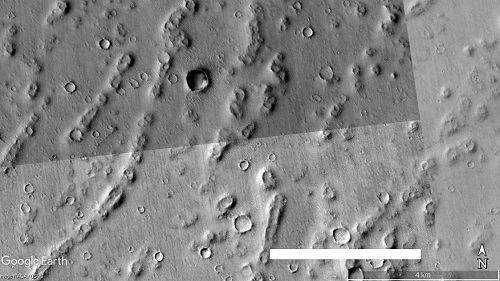Isidis Planitia: its regional and local characteristics
- 1University of Warsaw, Institute of Geophysics, Faculty of Physics, Warsaw, Poland (lczech@op.pl)
- 2Space Research Centre, Polish Academy of Sciences, ul. Bartycka 18A, 00-716 Warszawa, Poland (natalia@cbk.waw.pl)
Introduction: We consider the surface structures and geological history of Isidis Planitia on Mars. It is a plain located inside a large impact basin of ~1500 km in diameter. Its age is ~3.8 Ga ago [1, 2]. Geologic history of Isidis Planitia (or at least some of its parts) is quite complicated and many details remain unclear. We believe that better analysis of surface structures (especially chains of cones) and large deep structures (e.g. mascon) will allow a better understanding of the processes responsible for present structures of Isidis.
Formation of basin and mascon:
One of the large Martian mascon is located under Isidis. This is an anomalously high mass concentration below the surface. Such structures were discovered during the Apollo missions on the Moon. The formation of mascon is possible only under special physical conditions. Therefore, its existence is an important source of information about past conditions and can help us determine thermal conditions in the past of the basin.
We use numerical models to this problem. Preliminary results point that the model allows to determine thermal conditions and some tectonic processes in the period when the mascon was formed.
Role of comparison: Earth, Mars and Moon:
The possibility of comparing processes on different celestial bodies is important for our research [3]. Mars is a body of intermediate mass and size between Earth and the Moon. Therefore, it can be expected that some geological processes on Mars are similar to processes on Earth (e.g. volcanism) or the Moon (e.g. mascon’s formation).
Role of distributed volcanism and chains of cones:
We are examining the system of cones on Isidis Planitia. Many of these chains have a characteristic furrow through the center, suggesting that fissure volcanism along circumferential dikes was common in the Isidis area. The cones have diameter of 300–500 m and height of ~30 m. This means slopes of 7–11° which is consistent with explosive type of volcanism. Similar cones are known from Iceland (64°03′53″N 18°13′34″). Some of Isidis Planitia cones are without a furrow. We recognize this type of volcanism on the volcanic archipelago of the Canary Islands and in particular on Lanzarote. The cones on Isidis have been divided into a few types depending on their structures. Currently, we are working on determining the duration and age of their volcanic activity, as well as the size of related magma plumbing system, which might be related to Syrtis Major.
Regions of Isidis:
Our analysis of chains of cones indicates that they can be grouped in larger systems. In this way Isidis Planitia has been divided into several characteristic regions. These separated regions have characteristic pattern of cones or cone chains.
We present here two examples. They represent concentrically arranged chains of cones. Fig. 1 a, b. represent cones with a characteristic furrow passing through the center. In contrast, Fig. 2 a, b, show cones arranged concentrically around the crater, from which the outflows can be seen.. It is possible that these forms represent different origin, explosive (Fig. 1), and effusive (Fig. 2).
Figure 1a
CTX mosaic with characteristic concentric arranged cones with a characteristic furrow. Black arrows indicate the direction of the arches' propagation. White rectangle is 20 km long. Center of image: 14o51’04.22”N; 83o57’15.12”E

Figure 1b
Enlargement of the concentric cone area Fig. 1a. White rectangle – 4 km
Figure 2a
CTX mosaic with cones arranged concentrically around the crater. Characteristic outflows from cones are visible. Black arrows indicate the direction of the arches' propagation. White rectangle - 30 km. Center of image: 15o04’06.95”N; 81o16’14.87”E.
Figure 2b
Enlargement of the concentric cone area Fig. 2a. White rectangle - 4 km
References
[1] Ivanov, M.A., et al. 2012, Icarus. https://doi.org/10.1016/j.icarus.2011.11.029
[2] Rickman, H., et al. Planetary and Space Science, 166, 70–89, 2019.
[3] Czechowski, L., et al. 2020. LPSC 2020 in The Woodlands, Tx.
How to cite: Czechowski, L., Zalewska, N., and Ciazela, J.: Isidis Planitia: its regional and local characteristics, Europlanet Science Congress 2020, online, 21 September–9 Oct 2020, EPSC2020-795, https://doi.org/10.5194/epsc2020-795, 2020

